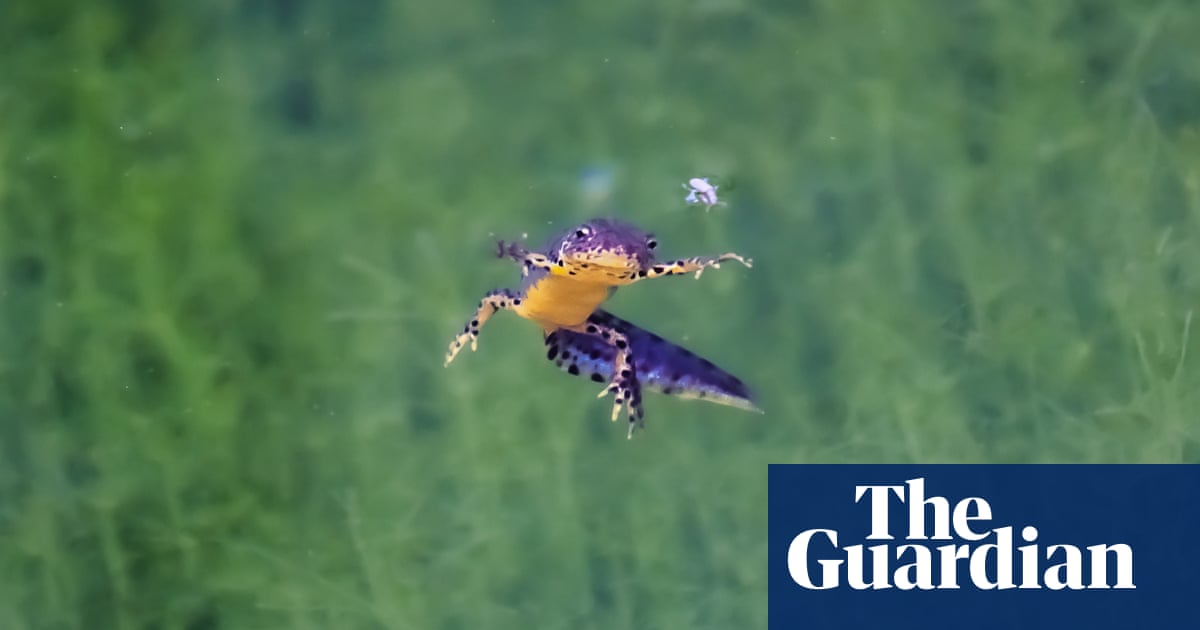
The heart of the Apuan Alps in Tuscany, Italy, is home to one of the biggest marble mines in the world, with about 160 active quarries in the Massa Carrara and Lucca areas. Since Roman times, creamy-white Carrara marble has been dug out of these mountains. It is the most sought-after marble in the world, and has inspired artists and architects everywhere.
But the Apuan Alps also host an ecosystem that is home to the Italian alpine newt (Ichthyosaura alpestris apuana). In November, Manuel Micheli, a photographer working with the Apuane Libere organisation, stumbled across the newt in Crespina 2, a decommissioned quarry.
“Between my feet, I found a small newt out of the water. Looking closer, I saw several dozen of them,” he says. The newt is protected by Italian law and categorised as “near threatened” on the IUCN red list of threatened species.
“It was incredible to discover such a group,” says Gianluca Briccolani, the co-founder of Apuane Libere, a volunteer organisation formed in 2021 to protect the mountains from environmental degradation, including water contamination caused by the heavy industrialisation of the marble industry.
Cava Crespina 2 lies under Monte Sagro and overlooks the Mediterranean. It was closed in 2014 and became a perfect place for newt reproduction thanks to an underground spring and rainwater filtration in conjunction with the lake’s impermeabilisation, caused by marble dust waste (marmettola).
Since Micheli’s discovery, the newt population has grown – and the scientific and local community has mobilised to protect the newts. Plans to reopen the quarry were halted earlier this month by Unesco and the Apuan Park.
“Last year, we counted at least three dozen newts in different life stages,” says the herpetologist Gabriele Martinucci. “This was a sensational discovery because it means they live in the quarry throughout the entire year. It’s a demonstration that, even in places transformed by industrial activities, nature can give life to something that wasn’t there, such as the newts.” But campaigners worry that the quarry could be reopened in the future.
In another nearby quarry that is active, the owner has experimented with extracting marble during the week, and at the weekend opening the quarry to visitors who want to see the newts – and are willing to buy an €8 entry ticket.
If the Crespina 2 quarry were to reopen, however, the newts there would need to be moved because the excavation would affect the lake where they live, says Apuane Libere.
“We want to do everything to protect the newts,” says Briccolani. “Marble quarrying has nothing to do with art. Entire blocks of marble are crushed to create the calcium carbonate that we find, for example, in our toothpaste. The well-known Carrara marble is no longer used to make the future Davids by Michelangelo, but ends up crumbled or, at most, in the kitchens and bathrooms of a very few rich people.”
It isn’t just newts that are threatened, say campaigners. The Apuan Alps chain hosts about 30% of endemic national flora, including a rare cornflower that grows on the slopes of Mount Borla. But the newts have become “a symbol of the resilience of Apuan biodiversity”, says Andrea Ribolini of the Italian Alpine Club.
Many of those protecting the environment in the area are the children of former quarry workers, including Alberto Grossi, a longstanding activist and group manager for the Apuan Alps of the Legal Intervention Group, an Italian ecological association. “Even if we come from families of quarry workers, now we hate this current system,” he says.
Guido Dazzi, a fellow environmentalist, says: “I’m 60 years old and my father was a quarry worker. I come here to monitor whenever I can. We are the only pocket of resistance in this territory.”












